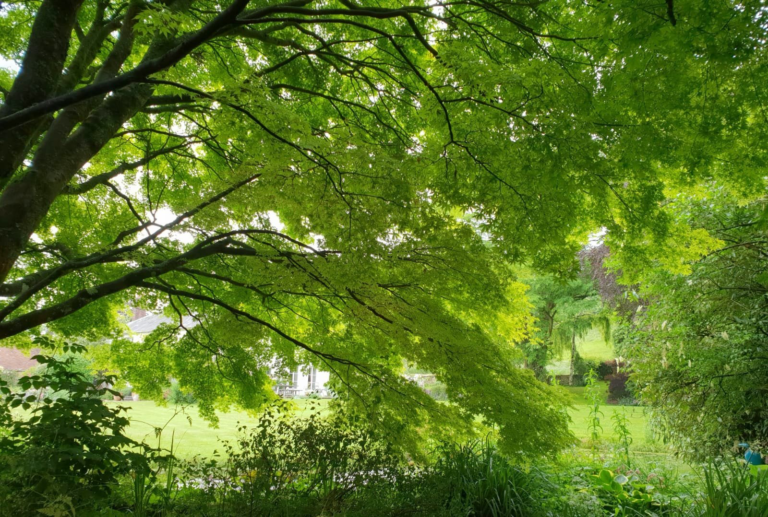In today’s modern society, humans are inevitably exposed to stress, constant use of digital devices, crowded urban environments, and heavy work, often leading to stress and anxiety. Spending time in nature, however, can help the human brain recover and improve their mental health. Research shows that being exposed to green nature, such as forests and parks, reduces stress levels and lifts one’s mood through vision, olfaction, and audition of nature, promoting healthier brains.
An MRI study has shown that people viewing nature sceneries reduced amygdala activity – a brain structure in the forebrain that deals with emotions, stress, and fears, etc., compared to those who looked at urban sceneries. This study illustrates that seeing green environments helps people reduce stress and fear levels as amygdala activity decreases. Furthermore, the color of nature, green, is perceived in the visual cortex in the occipital lobe and is linked to the parasympathetic nervous system – a type of autonomic nervous system that is responsible for resting and calming responses. Additionally, the wavelengths of green are easier to perceive, reducing eye strain and promoting relaxation.
Plants emit something called phytoncides – organic compounds that lower cortisol (stress) and enhance immune function. In addition, earthy smells, such as soil smell after rain or the smell of leaves of trees, allow human brains to increase serotonin and dopamine levels. An increase in serotonin levels can prevent humans from suffering from depression, making people feel happy and rewarded.
From the perspective of auditioning, when people hear nature sounds, including birds singing, flowing water, winds, etc., it engages the auditory cortex in the temporal lobe and stimulates the default mode network (DMN), which is a set of interconnected brain parts that is active when a person is not focused on the outside world. For example, during daydreaming, resting, or reflecting on the past, this region of the brain gets activated. Since DMN plays a significant role in creativity, empathy, the activation of DMN promotes relaxation of the brain and creative thinking. Moreover, similar to the effects of vision of nature on the brain, listening to the sound of nature also enables the brain to reduce activities in the amygdala and hypothalamus, reducing stress responses and negative thinking.
Wilderness also restores attention and creativity. While people are living in cities, they are constantly focused on digital screens, traffic, and signs and this weakens one’s capability to concentrate. Nonetheless, when people are surrounded by trees, rivers, or mountains, the brain can relax as the natural scenes engage our attention. Psychologists call it the “Attention Restoration Theory”. This theory demonstrates why spending time outdoors can make workers or students better focused or more creative afterwards.
Experts emphasize that one doesn’t need to go far to experience these impacts. A short walk in a park, or even exposure to plants inside the building, can positively influence mental well-being. These small interactions with nature accumulate over time and help balance emotions. As Edward Abbey stated that “wilderness is not a luxury but a necessity of the human spirit”. By reconnecting with natural environments, we can give a change to our brains to rest and recover.
In conclusion, exposure to green environments has profound impacts on human brains through visual, olfactory, and auditory pathways, reducing brain activities related to stress. These biological responses explain why spending time outdoors to refresh is essential to improve mental well-being. By preserving the natural world, we are not only saving the environment but also healing ourselves.
By. Minkyu Jung
Works Cited
Ackerman, Courtney E. “What Is Kaplan’s Attention Restoration Theory (ART)? Benefits +
Criticisms.” PositivePsychology.com, 13 Nov. 2018,
positivepsychology.com/attention-restoration-theory/?utm_source.
Bratman, Gregory N, et al. “Nature and Human Well-Being: The Olfactory Pathway.”
Science Advances, vol. 10, no. 20, 17 May 2024,
https://doi.org/10.1126/sciadv.adn3028.
Flynn, Vicky. “The Healing Power of Trees – National Garden Scheme.” National Garden
Scheme, 24 Apr. 2020, ngs.org.uk/the-power-of-trees/. Accessed 27 Oct. 2025.
Liu, Chao, et al. “Effects of Natural Sound on Human Stress Recovery Based on EEG
Techniques.” Journal of Environmental Psychology, vol. 97, 25 June 2024, pp.
102365–102365, https://doi.org/10.1016/j.jenvp.2024.102365. Accessed 6 Nov. 2024.
McDonnell, Amy S, et al. “Nature Images Are More Visually Engaging than Urban Images:
Evidence from Neural Oscillations in the Brain.” Frontiers in Human Neuroscience,
vol. 19, 17 June 2025, https://doi.org/10.3389/fnhum.2025.1575102.
Sudimac, Sonja, et al. “How Nature Nurtures: Amygdala Activity Decreases as the Result of
a One-Hour Walk in Nature.” Molecular Psychiatry, vol. 27, no. 11, 5 Sept. 2022,
www.nature.com/articles/s41380-022-01720-6,
https://doi.org/10.1038/s41380-022-01720-6.
““Wilderness Is Not a Luxury but a Necessity of the Human Spirit.”” Grow. Learn. Connect.
Blog., 25 Apr. 2024,
blog.jmrl.org/2024/04/24/wilderness-is-not-a-luxury-but-a-necessity-of-the-human-sp
irit/. Accessed 27 Oct. 2025.


